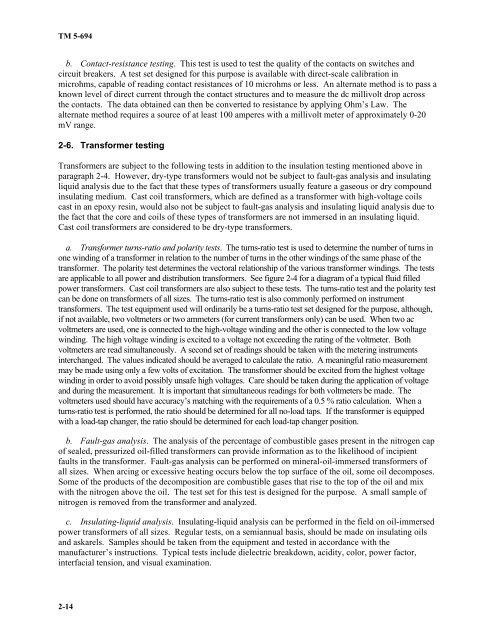Commissioning of Electrical Systems for Command, Control
Commissioning of Electrical Systems for Command, Control
Commissioning of Electrical Systems for Command, Control
You also want an ePaper? Increase the reach of your titles
YUMPU automatically turns print PDFs into web optimized ePapers that Google loves.
TM 5-694<br />
b. Contact-resistance testing. This test is used to test the quality <strong>of</strong> the contacts on switches and<br />
circuit breakers. A test set designed <strong>for</strong> this purpose is available with direct-scale calibration in<br />
microhms, capable <strong>of</strong> reading contact resistances <strong>of</strong> 10 microhms or less. An alternate method is to pass a<br />
known level <strong>of</strong> direct current through the contact structures and to measure the dc millivolt drop across<br />
the contacts. The data obtained can then be converted to resistance by applying Ohm’s Law. The<br />
alternate method requires a source <strong>of</strong> at least 100 amperes with a millivolt meter <strong>of</strong> approximately 0-20<br />
mV range.<br />
2-6. Trans<strong>for</strong>mer testing<br />
Trans<strong>for</strong>mers are subject to the following tests in addition to the insulation testing mentioned above in<br />
paragraph 2-4. However, dry-type trans<strong>for</strong>mers would not be subject to fault-gas analysis and insulating<br />
liquid analysis due to the fact that these types <strong>of</strong> trans<strong>for</strong>mers usually feature a gaseous or dry compound<br />
insulating medium. Cast coil trans<strong>for</strong>mers, which are defined as a trans<strong>for</strong>mer with high-voltage coils<br />
cast in an epoxy resin, would also not be subject to fault-gas analysis and insulating liquid analysis due to<br />
the fact that the core and coils <strong>of</strong> these types <strong>of</strong> trans<strong>for</strong>mers are not immersed in an insulating liquid.<br />
Cast coil trans<strong>for</strong>mers are considered to be dry-type trans<strong>for</strong>mers.<br />
a. Trans<strong>for</strong>mer turns-ratio and polarity tests. The turns-ratio test is used to determine the number <strong>of</strong> turns in<br />
one winding <strong>of</strong> a trans<strong>for</strong>mer in relation to the number <strong>of</strong> turns in the other windings <strong>of</strong> the same phase <strong>of</strong> the<br />
trans<strong>for</strong>mer. The polarity test determines the vectoral relationship <strong>of</strong> the various trans<strong>for</strong>mer windings. The tests<br />
are applicable to all power and distribution trans<strong>for</strong>mers. See figure 2-4 <strong>for</strong> a diagram <strong>of</strong> a typical fluid filled<br />
power trans<strong>for</strong>mers. Cast coil trans<strong>for</strong>mers are also subject to these tests. The turns-ratio test and the polarity test<br />
can be done on trans<strong>for</strong>mers <strong>of</strong> all sizes. The turns-ratio test is also commonly per<strong>for</strong>med on instrument<br />
trans<strong>for</strong>mers. The test equipment used will ordinarily be a turns-ratio test set designed <strong>for</strong> the purpose, although,<br />
if not available, two voltmeters or two ammeters (<strong>for</strong> current trans<strong>for</strong>mers only) can be used. When two ac<br />
voltmeters are used, one is connected to the high-voltage winding and the other is connected to the low voltage<br />
winding. The high voltage winding is excited to a voltage not exceeding the rating <strong>of</strong> the voltmeter. Both<br />
voltmeters are read simultaneously. A second set <strong>of</strong> readings should be taken with the metering instruments<br />
interchanged. The values indicated should be averaged to calculate the ratio. A meaningful ratio measurement<br />
may be made using only a few volts <strong>of</strong> excitation. The trans<strong>for</strong>mer should be excited from the highest voltage<br />
winding in order to avoid possibly unsafe high voltages. Care should be taken during the application <strong>of</strong> voltage<br />
and during the measurement. It is important that simultaneous readings <strong>for</strong> both voltmeters be made. The<br />
voltmeters used should have accuracy’s matching with the requirements <strong>of</strong> a 0.5 % ratio calculation. When a<br />
turns-ratio test is per<strong>for</strong>med, the ratio should be determined <strong>for</strong> all no-load taps. If the trans<strong>for</strong>mer is equipped<br />
with a load-tap changer, the ratio should be determined <strong>for</strong> each load-tap changer position.<br />
b. Fault-gas analysis. The analysis <strong>of</strong> the percentage <strong>of</strong> combustible gases present in the nitrogen cap<br />
<strong>of</strong> sealed, pressurized oil-filled trans<strong>for</strong>mers can provide in<strong>for</strong>mation as to the likelihood <strong>of</strong> incipient<br />
faults in the trans<strong>for</strong>mer. Fault-gas analysis can be per<strong>for</strong>med on mineral-oil-immersed trans<strong>for</strong>mers <strong>of</strong><br />
all sizes. When arcing or excessive heating occurs below the top surface <strong>of</strong> the oil, some oil decomposes.<br />
Some <strong>of</strong> the products <strong>of</strong> the decomposition are combustible gases that rise to the top <strong>of</strong> the oil and mix<br />
with the nitrogen above the oil. The test set <strong>for</strong> this test is designed <strong>for</strong> the purpose. A small sample <strong>of</strong><br />
nitrogen is removed from the trans<strong>for</strong>mer and analyzed.<br />
c. Insulating-liquid analysis. Insulating-liquid analysis can be per<strong>for</strong>med in the field on oil-immersed<br />
power trans<strong>for</strong>mers <strong>of</strong> all sizes. Regular tests, on a semiannual basis, should be made on insulating oils<br />
and askarels. Samples should be taken from the equipment and tested in accordance with the<br />
manufacturer’s instructions. Typical tests include dielectric breakdown, acidity, color, power factor,<br />
interfacial tension, and visual examination.<br />
2-14
















